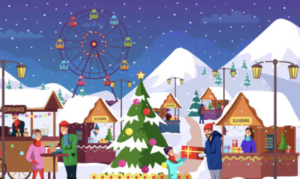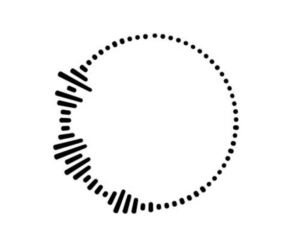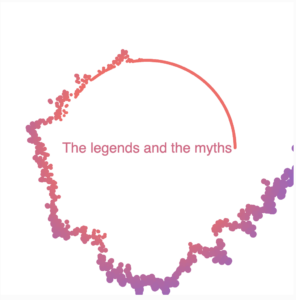Concept
As we approach the festive months of the year, all I can think about is winter break, my favorite holiday. The warmth, comfort, excitement, and simple joys that this season brings are what I eagerly anticipate for months. When considering ideas for this open-ended and creative project, I wondered if there were others like me who simply can’t wait for the Christmas season and New Year. Thus, I decided to create an Early Christmas Experience as an ode to one of my favorite festivals. The candy canes from school, the joy of exchanging gifts during Secret Santa, and the delight of decorating the Christmas tree are just a few things that make this season special, and I aimed to incorporate them into my project. From the reading ‘Making Art is like setting a trap’, my takeaways were to focus on and convey the simpler things and the feelings behind it
My project aimed to encapsulate the essence of Christmas, focusing on two central elements: decorating a Christmas tree and the excitement of hunting for hidden presents around a cozy house—both cherished traditions in my family. Having spent my entire life in a region where snowfalls are rare, I yearn for snowy vacations. For this project, I wanted to create a visually captivating experience, making it heavily reliant on graphics rather than physical and mechanical elements.
How It Works:
The experience begins with a screen featuring a play button. Upon clicking this button, users are transported to the experience screen—the screen of magic. Santa himself makes an appearance, offering brief instructions on how to navigate the experience. Users can click on the Christmas tree and decorate it by dragging and dropping ornaments. These decorations are saved for later viewing. Clicking on the house triggers a mini Christmas-themed hidden object game. The objective is to find a minimum of 5 presents to win. Throughout the experience, a snowy backdrop adds to the festive atmosphere, and users can navigate through the various parts of the experience using marked buttons in the form of presents with a carol playing in the background and end with a real – time countdown to Christmas.
View directly in the editor for sound , re run and let Santa guide you further! https://editor.p5js.org/keyaa/full/lvw7KccaA
Technical Parts I’m Proud Of
The Christmas tree was a major highlight of my project. While the drag-and-drop functionality for ornaments was easy with the reference shared in class, a significant challenge was saving the positions of these ornaments and placing them exactly on the experience screen tree as the user had arranged them on the tree screen. After multiple experiments with vectors in p5.js and other coordinate system functions, I chose to calculate the relative positions of X and Y coordinates of the ornaments and confirm if they were correctly placed on the tree. To add a more realistic touch, I included a layer of snow with gradually decreasing velocity, simulating the accumulation of snow on the tree. This was a personal favorite effect that enhanced the overall experience.
if (decorated == true) {
for (let draggableObject of draggableObjects) {
if (draggableObject.onTree) {
draggableObject.x = draggableObject.relativeX + treeX;
draggableObject.y = draggableObject.relativeY + treeY;
draggableObject.show();
}
}
}
// Check if snowflakes2 touch the tree
for (let snowflake of snowflakes2) {
const distanceToTreeCenter = dist(snowflake.x, snowflake.y, treeX + christmasTree.width / 2, treeY + christmasTree.height / 2);
if (distanceToTreeCenter < 70) {
snowflake.speed = 0;
}
snowflake.update();
snowflake.display();
}
The typewriter effect for Santa’s words:
typewriterEffect() {
if (this.index < this.message.length) {
this.displayedMessage += this.message[this.index];
this.index++;
}
}
The usage of OOP and arrays is at the core of this project. It simplified tasks and made the project more organized. Creating Santa’s movement using sprites was a more significant challenge than anticipated. To enhance the visual appeal, I incorporated images from Shutterstock and designed some of my own using PicMonkey and Canva, opting for efficiency over drawing everything directly in p5.js.
Areas for Improvement
While I’m pleased with the project’s overall outcome, there are many other areas that I can improve and add to. Adding more challenging elements to the hidden objects game, such as a timer, or refining Santa’s movement for smoother animation, could make the project better.
In conclusion, creating this Christmas-themed interactive project for my midterm assignment was a delightful experience. I tried to work more on my creative skills instead of just coding like I would for other classes. I tried to incorporate most of the concepts learnt over the past few weeks and am already excited to see what the second half of the semester in this class holds for me to learn!
References
https://www.shutterstock.com/image-vector/bright-new-year-santa-claus-2d-1563199690, https://www.youtube.com/watch?v=bKEaK7WNLzM, https://www.youtube.com/watch?v=3noMeuufLZY, https://editor.p5js.org/codingtrain/sketches/U0R5B6Z88
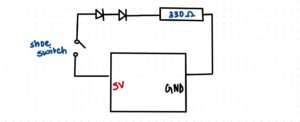 I experimented with various methods to create a switch using two aluminum foil sheets and settled on the following design. I attached one sheet to the back of a sandal and the other to the floor. When stepped on the second sheet, both pieces of foil come in contact and the circuit closes, allowing the LEDs to glow.
I experimented with various methods to create a switch using two aluminum foil sheets and settled on the following design. I attached one sheet to the back of a sandal and the other to the floor. When stepped on the second sheet, both pieces of foil come in contact and the circuit closes, allowing the LEDs to glow.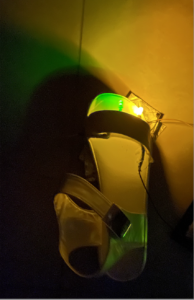 One significant challenge I encountered was positioning the lights on the shoes instead of using a breadboard. To make this work, I used a combination of jumper wires, aluminum foil, and tape. I also intended to use three LEDs: yellow, green, and blue. While the yellow and green LEDs worked when connected in series, the blue LED did not. I suspected it was due to insufficient current, as the bulb wasnt faulty. I tried various resistor combinations but they did not work.
One significant challenge I encountered was positioning the lights on the shoes instead of using a breadboard. To make this work, I used a combination of jumper wires, aluminum foil, and tape. I also intended to use three LEDs: yellow, green, and blue. While the yellow and green LEDs worked when connected in series, the blue LED did not. I suspected it was due to insufficient current, as the bulb wasnt faulty. I tried various resistor combinations but they did not work.

